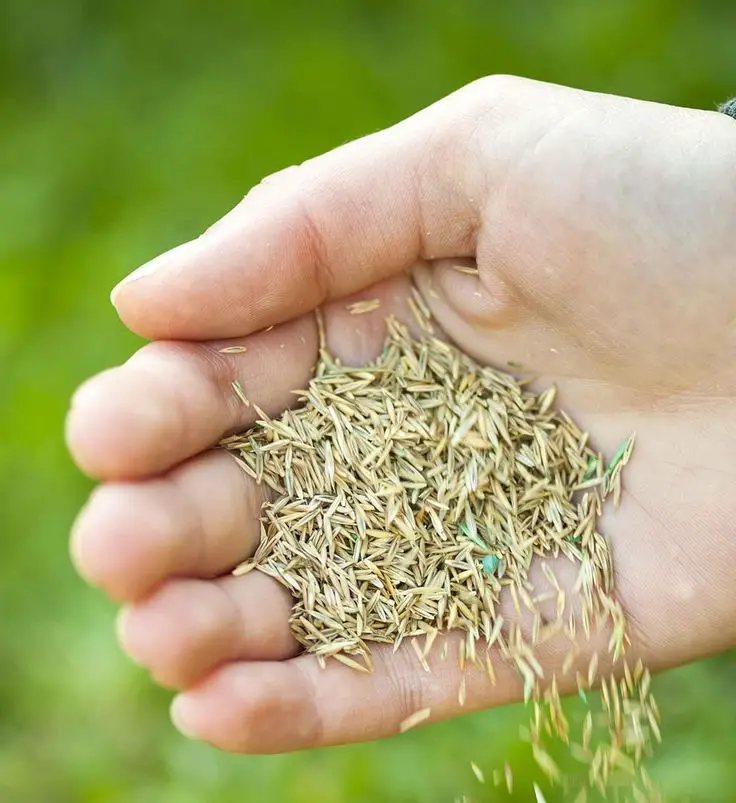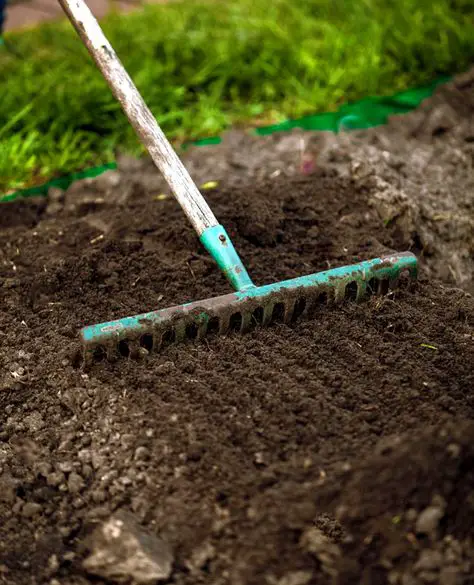Do I Have To Rake In Grass Seed
Raking is necessary because the seeds need to come in contact with the soil to germinate properly. Grass seed is typically spread on the lawn using a spreader and this does not ensure good contact between seed and soil. … This is important because a newly seeded lawn will need to be watered at least every other day.
How Can I Make Grass Seed Germinate Faster
To make grass seed germinate faster:
- Choose the best grass seed for the location
- Prepare the area by raking the soil to loosen it, removing stones and weeds
- Apply a pre-seeding fertilizer and water the soil
- Apply seeds evenly over the area, press them down and keep the soil moist
- Apply a fertilizer after sowing if you haven’t beforehand and then feed the emerging grass about every month.
How Long Does Grass Seed Take To Grow Fully
It can take up to a week or more for the seeds to grow, but most grass seeds will start growing in a few days. I know if my seedlings are ready to be transplanted into my garden? .
If you have a seedling in your garden that is not growing well, you may want to consider transplanting it into a larger container. This will allow the plant to grow in a more natural environment, and will also allow you to control the amount of light and water it receives.
You May Like: What To Put On Lawn To Make It Green
Two: Add Compost Into The Soil
After the second day of watering, loosen up the soil and apply compost or fertilizer to it. Mix up the compost and the soil, using a rake, and ensure it is evenly spread and leveled. Raking also removes any unwanted debris from the soil.
Give the compost time to break down and mix well with the soil before applying another layer of compost. Ensure your compost has a nitrogen component in it because it is an agent that promotes plant growth and gives plants their glorious green color.
Overseeding An Existing Lawn

You can overseed at other times of the year. Spring , is also a favourite time for overseeding. Just remember grass seed germination relies on two main factors soil temperature, and moisture. Grass seed needs soil temperatures to be at least 7-8 degrees celsius, and frequent rainfall is important to ensure the seed germinates. See also: How long does seed take to grow.
The area to be over-sown should ideally be closely mown and then scarified or in some way prepared in order that the seeds can be carefully incorporated into the surface mineral soil bypassing any thatch or organic matter present at the surface.
Select a suitable mixture of grass seed using the Lawn UK lawn wizard.
Ideally, sow the seed after the ground has been thoroughly wetted by a good fall of rain.
Mix the seed in a bucket with equal proportions of a suitable carrier such as general purpose compost and sand a light garden soil could be used but would need to be sterilised in order to eliminate the numerous weed seeds liable to be present.
For best results, the mixture needs to be moist and spread evenly over the target areas.
The use of a compound fertiliser such as a proprietary lawn feed which is low in nitrogen is also likely to be necessary and would be instrumental in hastening seedling establishment and recovery of the existing lawn.
Keep off the newly over-seeded area if possible until new seedlings are firmly anchored.
Read Also: Who Picks Up Old Lawn Mowers
Get Your Lawn Ready For Overseeding
Before you start overseeding, it is very important to prepare the lawn. You just need to follow the simple and easy points mentioned below:
Watering: Deeply water the lawn before mowing even if you are planting a new garden or overseeding. For the whole renovation of the lawn, it is recommended to dig the ground to 3 inches. You can use a sprinkler system or lawn watering kit.
Mowing: If the grass in your lawn is longer than 2 inches, cut it short to a height of 2 inches using a lawnmower. Bag or rake the clippings. Its better to set the mower to the lowest setting while mowing.
Dethatching the soil: A dead turfgrass tissue that accumulates on the surface of the soil is called thatch and its mechanical removal is known as dethatching. After mowing, dethatch the accumulated layer of dead grass over the soil by using a dethatcher pulled behind a riding mower.
Aeration: Next step is to aerate your lawn by using a plug or spike aerator. If there is any compact soil, break it down to ensure the proper oxygen and nutrient flow.
Fertilizer: After aeration, apply a starter high phosphorus fertilizer. Follow the guide of the manufacturer to confirm the amount of fertilizer. Typically, 3.8 pounds of fertilizer is required for 1000 square feet of lawn.
How To Plant Grass Seeds On The Existing Lawn In The Fall
Are you concerned about planting grass seeds on the existing lawn in the fall? If yes, you should not worry. Its procedure is similar to that of overseeding in spring with the only difference of sowing seeds in the aeration holes. You should select the climate favorable grass just like cool-season grasses are bluegrasses, fine and tall fescues, and ryegrasses.
Shortly, overseeding of the cool-season grass needs aeration of the whole lawn. After this, fall the seeds in the aeration holes. You can also use the back of a rack to put more seeds in the holes. It is a pro tip to prevent the seed from drying out in the cool weather. As a result, the seeds will germinate quickly.
Apply the fall fertilizer and water the seeds one to two times a day. Normally, the seeds require 2 weeks to germinate. Once the new grass reaches the height of the existing grass, you can use a mower to manicure the lawn.
You May Like: How Much To Pay For Lawn Mowing
The Benefits Of Overseeding
Many older lawns were established with common type turf grasses not suited for the needs of todays homeowner. Theyre often more disease and insect prone, requiring more fertilizer and water.
Overseeding newer turfgrass varieties into an older lawn can help it better withstand insects, disease, drought, shady conditions and heavy traffic. The investment in overseeding pays off by reducing the amount of fertilizer, water and pesticides required. Most importantly, a renovated lawn stays greener and looks thicker and healthier!
Return To Regular Maintenance
Keep your newly revived lawn looking its best with a regular, comprehensive maintenance plan that includes diligent watering, best mowing practices and proactive overseeding. A simple weekday lawn maintenance schedule can keep your lawn lush and your weekends free.
For a simple, all-in-one approach to a thicker lawn, you can put your lawn on the fast track with Pennington Lawn Booster. This easy-to-use product simplifies overseeding to give your lawn the boost it needs. In just one application, your lawn will grow quicker, thicker and greener than ordinary grassguaranteed.
Available in formulas for sun & shade or tall fescue lawns, Lawn Booster combines three essentials: seed, fertilizer and soil enhancer. Lime-enhanced, pure-bred Pennington Smart Seed, backed by years of breeding and research, adds beauty and sustainability. Once established, these water-conserving grasses require up to 30 percent less water than ordinary grasses. That’s year after year, for the life of your lawn. Plus, they stay green up to three weeks without watering. That means less work and more leisure time for you.
For the lawn of your dreams, don’t wait to overseed until your lawn looks less than its best. Give your lawn the boost it needs, step-by-step or all-in-one. Pennington’s here with premium grass seed and lawn care products to help you keep your lawn at its peak.
Pennington, One Step Complete, Smart Seed, and Ultragreen are trademarks of Pennington Seed, Inc.
Read Also: Who Makes Greenworks Lawn Mowers
Can You Plant Too Much Grass Seeds
Its a common misconception that when it comes to planting seeds in general, the more the merrier is applicable. This is really not the case, especially when you are overseeding or reseeding your lawn.
What you really should know is that using too many seeds wont really make your lawn look lush and healthier.
In fact, too many grass seeds trying to grow at the same time can make germination a struggle.
You need to keep in mind that all types of plants, including grass, need space and enough nutrients to germinate and grow healthily.
When theres just too many of them, healthy growth may not be possible.
Is April Too Early To Plant Grass Seed
You can plant grass seed too early in the spring. Poor germination can be caused by planting too early in the spring. Wait for the air and soil temperature to warm up so that you can plant your seed. The best way to tell if your seeds are ready for planting is to look at them.
If they are green, then you have a good chance of planting them successfully. The reason for this is that the seed coat is not fully formed. This means that it will take a long time for it to grow into a healthy plant.
Recommended Reading: How To Care For Lawn In Spring
Planting Grass Seed In Spring
Spring is another great time to seed the lawn. Its particularly good if you live where springs are long and cool. For spring planting, its absolutely essential that you continue to regularly water the seed and the sprouted grass through the remainder of the spring, summer, and well into the fall. Establishment failures are often connected to improper watering. Early summer is another possible time, but youll need to water more often.
Fertilize The New Grass

Using the fertilizer spreader once again, spread a lawn starter fertilizer anywhere you just added seed. Starter fertilizers are especially formulated for new grass. They help the seedlings establish strong roots and sprout faster.
When choosing a fertilizer, avoid weed and feed combinations. The herbicides in weed and feed would keep the new grass from growing.
Note: If your seed mixture already contains fertilizer, skip this step.
Also Check: Who Makes The Best Lawn Edger
Federal Seed Act Ensures Proper Labeling
When it comes to selecting seeds, the Federal Seed Act requires seed sellers to provide consumers with valuable information on the seeds label.
Under the law, the label must tell you:
- The name of the grass variety .
- Its purity, that is, the weight by percentage of each type of seed.
- Germination percentage. The percentage of the seeds that you can expect to germinate. This is not a number the seed companies can fudge. The federal government expects seed producers to run regular germination tests and keep careful records.
- Weed seed percentage. Look for a seed that has less than 0.5 percent weeds.
How To Sow Grass Seed For An Existing Lawn
If you have an existing lawn that bears the signs of age , then overseeding is a great fix.
Thinning lawns are prime real estate for weeds and pests, so reseeding your lawn will help keep the weeds down and the pests at bay.
Overseeding is a simple process of scattering seed over the existing lawn, concentrating mainly on the bald/dying spots. But be sure to rake and roll the soil afterwards to ensure even distribution and ample soil contact. More about that coming up.
Recommended Reading: How To Make Lawn Grass Green
Can You Overseed Over Dead Grass
A direct answer to this is simply yes, you Can seed over dead grass. However, I dont recommend this at all as it will simply make your lawn look like a mess and even abandoned.
If your lawn is only composed of dead grass, then its best that you remove the dead grass completely.
If your lawn only has a few spots with dead grass, just remove those spots and make sure that you put enough seed on those areas.
Generally, total lawn renovation is best if your lawn only has dead grass. This is to make sure that your lawn ends up looking good once the seeds have already grown.
Related post:Will Watering Dead Grass Bring My Lawn Back Life?
Treat Your New Grass Like A Baby
Take advice from the 70s band, The Eagles. Slow down and take it easy the first few times you mow your new turfgrass. The roots wont be long or well-established, so it will be easy to accidentally rip up the young plants.
Here are a few tips to ensure a successful first mow:
- Sharpen the mowers blade so you cut, not tear, the tender plants.
- Start the mower off the lawn and minimize the number of turns you make with the mower.
- Dont remove more than a third of the grass blade in one mow.
After the first mow, cut back on frequent shallow watering, and switch to watering a couple of times a week, deeply. Water six or eight inches deep to encourage your new lawn to root deeply. Once established the lawn will start spreading to cover any gaps.
After eight weeks, your lawn should be well-established. Hit it with a little more fertilizer to encourage deep roots, and take down your Please keep off the new grass signs your new lawn is ready for fun.
Also Check: How To Rid Your Lawn Of Dandelions
Overseeding Lawn: How To Plant Grass Seed On Existing Lawn
The grass on your lawn can affect the overall look and curb appeal to your home.
The weather keeps changing and you can only expect the grass on your lawn to eventually lose its plush and green look.
When this happens, it may be time to grow new grass. However, its one thing to start with a bare lawn, and its another to plant more seeds on an existing lawn.
If you want to know how overseeding a lawn will help it look green and plush, then this post will let you know what you need and when to overseed your lawn.
Related post: Best Time to Aerate and Overseed Your Lawn
Its just normal that your grass wont remain green and healthy-looking for a long time.
In fact, it might only take a few weeks or months before the deep green grass that you have change into something lighter and even thin.
Maintenance is important and planting grass seeds on your existing lawn is the way to go.
The only way to make sure that you keep your lawn lush and green is by overseeding. What does overseeding mean? Its simply how to plant grass seed on an existing lawn.
Planting new grass seed on the existing lawn is a process that can keep your lawn look healthy and greener than ever.
Before we get into it, we wanted to share our top recommendations of grass seeds that we and our landscapers like to use. Check them out and let us know what you think.
How To Plant Grass Seeds On The Existing Lawn In Spring
Well, are you planning to overseed your lawn in spring? If yes, follow are tips mentioned below.
- Select the grass better suited to your garden and mating climate.
- For spring, warm-season grasses like Bermuda, and Bahia grasses can be overseeded from March through September.
- Simply prepare your existing lawn by watering mowing, bagging the clippings.
- Dethatch the soil and properly aerate the lawn following our above-mentioned guidelines.
- Fertilize the lawn using a phosphorus-rich fertilizer.
- Spread the seeds using a spreader.
- Water the seeds more often until the newly germinated seeds become 1 inch in height.
- Make sure not to mow and apply pesticides after germination.
- Once the grass has reached the height of existing plants, mow the garden as required.
Recommended Reading: When To Aerate Your Lawn
Add Fertilizer Or New Topsoil
After tilling, you can add fertilizer and/or new nutrient-rich topsoil all over your existing lawn. I recommend raking in the new soil into a smooth level. Take care to manually remove any leftover debris such as dead roots or rocks.
Take note that seeds require a level and smooth environment to germinate effectively. Avoid skipping on this step, or end up with a patchy lawn once the grass grows.
Choose The Right Seed

This is the most important step, get this wrong and you may end up making your lawn look worse rather than better. Different species of grass can look very different so you want to avoid mixing types if at all possible. If you are unsure a mixed seed containing a few different kinds of grass could work well as it will help blend the different grasses together. Look for a mixed seed with ryegrass and fescue.
You May Like: Do It Yourself Lawn Weed Control
One: Prepare The Land
The initial step is to clear the area with the hard soil. Dig out the hard, rocky soil and dispose of it in an appropriate place. Once all the rocky soil is cleared, you can purchase a truckload of quality topsoil or dig out some from the side of your lawn that has good soil and spread it over the space you just cleared.
Ensure you spread the soil evenly across the yard using a rake, then water it to ensure the soil absorbs as much moisture as possible. You can water it for 2-3 days before moving to the next step. Understand that growing grass on hard soil is more time-consuming but rewarding in the end.
